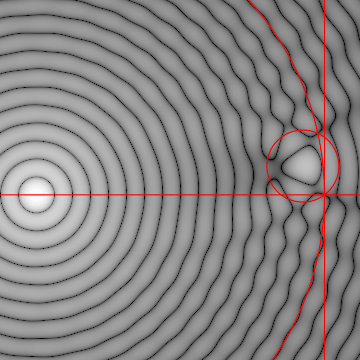SOUND:
Sound is a mechanical wave that is an oscillation of pressure transmitted through a solid, liquid, or gas, composed of frequencies within the range of hearing.Sound also travels through plasma.
Sound is a sequence of waves of pressure that propagates through compressible media such as air or water. Sound that is perceptible by humans has frequencies from about 20 Hz to 20,000 Hz.

Sound waves are produced by vibrating objects. Whether it be the sound of a person's voice, the sound of a piano, the sound of a trombone or the sound of a physics book slamming to the floor, the source of the sound is always a vibrating object.
A tuning fork serves as a useful illustration of how a vibrating object can produce sound. The fork consists of a handle and two tines. When the tuning fork is hit with a rubber hammer, the tines begin to vibrate. The back and forth vibration of the tines produce disturbances of surrounding air molecules. As a tine stretches outward from its usual position, it compresses surrounding air molecules into a small region of space, this creates a high pressure region next to the tine.
As the tine then moves inward from its usual position, air surrounding the tine expands; this produces a low pressure region next to the tine. The high pressure regions are known as compressions and the low pressure regions are known as rarefactions. As the tines continue to vibrate, an alternating pattern of high and low pressure regions are created. These regions are transported through the surrounding air, carrying the sound signal from one location to another.

Sound waves of Tuning Fork
Here is the link shows the animation on the sound waves.....
Animations of Sound Waves
Sound is a mechanical wave that is an oscillation of pressure transmitted through a solid, liquid, or gas, composed of frequencies within the range of hearing.Sound also travels through plasma.
Sound is a sequence of waves of pressure that propagates through compressible media such as air or water. Sound that is perceptible by humans has frequencies from about 20 Hz to 20,000 Hz.
The behavior of sound propagation is generally affected by three things:
- A relationship between density and pressure. This relationship, affected by temperature, determines the speed of sound within the medium.
- The propagation is also affected by the motion of the medium itself. For example, sound moving through wind. Independent of the motion of sound through the medium, if the medium is moving, the sound is further transported.
- The viscosity of the medium also affects the motion of sound waves. It determines the rate at which sound is attenuated. For many media, such as air or water, attenuation due to viscosity is negligible.

simple simulation of sound waves traveling in air
Longitudinal Waves and Tuning Forks
A tuning fork serves as a useful illustration of how a vibrating object can produce sound. The fork consists of a handle and two tines. When the tuning fork is hit with a rubber hammer, the tines begin to vibrate. The back and forth vibration of the tines produce disturbances of surrounding air molecules. As a tine stretches outward from its usual position, it compresses surrounding air molecules into a small region of space, this creates a high pressure region next to the tine.
As the tine then moves inward from its usual position, air surrounding the tine expands; this produces a low pressure region next to the tine. The high pressure regions are known as compressions and the low pressure regions are known as rarefactions. As the tines continue to vibrate, an alternating pattern of high and low pressure regions are created. These regions are transported through the surrounding air, carrying the sound signal from one location to another.

Sound waves of Tuning Fork
Here is the link shows the animation on the sound waves.....
Animations of Sound Waves
No comments:
Post a Comment
Thank you for your valuable suggestion. If you feel this post useful, please share our Blog with others!!! Comments just for Backlinking your Website or Blog will be Deleted...